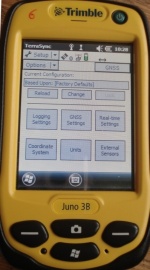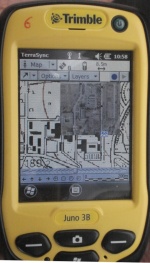Trimble Juno GPS
From AWF-Wiki
(Difference between revisions)
| Line 1: | Line 1: | ||
| − | + | {{author|name=[[User:yanti|Yanti Sarodja]]}} | |
| + | ''In this exercise you'll get an introduction on how to handle a the | ||
| + | [[:wikipedia:GPS navigation device|GPS receiver]] ''Trimble Juno 3B'' by [[:wikipedia:Trimble navigation|Trimble navigation]].'' | ||
| + | |||
| − | |||
| − | |||
| − | |||
| − | |||
| − | |||
Revision as of 12:08, 28 October 2014
Author of this article: Yanti Sarodja
In this exercise you'll get an introduction on how to handle a the
GPS receiver Trimble Juno 3B by Trimble navigation.
Getting started with the GPS receiver
Startup and configuration
- Press the power button for a few seconds
- Open the windows menu (by selecting on screen or pushing the windows-button) and select TerraSync --> Professional Edition. You are redirected to the Status menu, with a compass rose displayed in the center of the screen. Wait for a few minutes, until you get a connection to at least three satellites, which are displayed by little symbols on the compass rose.
- Set the coordinate system and other parameters
- To set the coordinate system and other parameters, select the upper of the two pull down menus at the top left corner of the screen (right now, Status should be displayed here). Select Setup. Alternatively, you can select the wrench symbol to enter the setup menu (see figure A).
- Select the Coordinate system menu.
- Set all parameters to the desired configuration:
- For this exercise, you can select Germany under System, UTM Zone 32 as the Zone and WGS 1984 as the Datum. Leave all other configurations as they are.
- Confirm with Done.
To find a specific spatial point:
- Set the target
- Select the upper pull-down menu, which now should display Status. Select Data, and select Existing file from the pulldown menu below.
- Select the device where the data is stored under Location. Some exemplary data is stored under Storage card. Select Tree waypoints from the displayed file list and click Open. Just confirm the dialogue prompting you for the antenna height. A list with wayponints should appear.
- Select the point you want to navigate to (e.g. Tree01).
- Click Options-->Set Nav Target and set the point you selected before.
- Set the background map
- Select the upper pulldown menu and Map.
- Click Layers and check make sure that Background and GNSS trail are checked. Select the Background files... menu and check the file(s) you want to load. (e.g. aerial_utm32_WGS84n) and confirm with Done. The background map should now be displayed (see Figure B).
- To zoom in to your location on the map, select Option --> Auto pan to GNSS position or Auto pan to selection for manual zooming.
- Your position appears as x and the selected target as flag symbols on the map.
- Navigation to the target:
- Select Navigation from the top-left pulldown menu.
- Follow the displayed compass and also check the Distance field at the bottom-left of the screen. Note that you need to move to get the compass working.
- To add an own ground control point (GCP):
- Standing at the desired point, select Data from the top-left pulldown menu. From the pulldown menu right below, select New and enter the name of the point (e.g. GCP01). Confirm by clicking Create. Also confirm the antenna-height prompt as it is.
- In the next menu, sellec Point generic. You can add a comment to give the point a label (for simplicity, you may just enter the name again).
- Before you're done, the spatial data of the ppoint must be updated. In order to do this, first select Options --> Logging interval and set the interval to 1 second.
- Click the Log button. A counter will appear at the top-right corner of the screen. Wait until it has reached 100 and press Done. Confirm with Yes and your point is saved.

